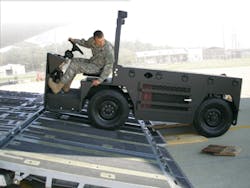At the 2007 GSE Expo in March, Eagle Tugs unveiled a new military prototype called USATS (pronounced u-sats), for Utility Standard Aircraft Towing System. The JP-8 diesel-run USATS is a combination aircraft tow tractor, and a flat bed truck, created based on the Army’s need for a multi-functional vehicle.
“We were looking for a vehicle that was all-wheel-drive all the time,” says First Sergeant JT Lee of Fort Campbell. “We were looking for something that could tow more than 25,000 pounds and also serve as an aircraft tug. We needed it to seat at least three people with seatbelts and we also needed it to drive on gravel as well as hard surface. Any time we spend the taxpayer’s money we have to make sure a vehicle can fill more than one need. ”
A good history
At Fort Campbell, the Army had been using Eagle All Wheel Drive (AWD) TT-series aircraft tractors since the late 1990s. According to Lee, the previous Eagle tractors had performed well for the Army.
“Our unit currently uses the Eagle TT 8 and the great thing about the Eagle TT 8 and USATS is they run off the exact same power train, same engine and the same axel, so cost to the government is minimal because we don’t have to stock more than one item to repair a vehicle,” Lee explains. “Right now we’re getting around 2,500 hours between failures [for the TT 8] and I think the only thing we’ve ever had to do on it — besides oil changes and changing filters is to replace a steering hydraulic pump.”
Functionality a must
According to USATS lead engineer, Dennis Morrow, it was crucial the unit perform well in challenging environments and possess the ability to haul Army equipment like the Blackhawk helicopter.
“As a military vehicle it has to be air-liftable,” he says. “It has to be able to go into undeveloped areas; it has to be supportable with the same fuel that helicopters use and the Humvees use. All of that equipment must be running on the same fuel.
“The crucial part was making sure the weight distribution was correct,” Morrow explains. “The USATS had to achieve at least a 5,000 pound drawbar pull unloaded, yet be able to have equal weight distribution front-to-back carrying 2,000 pounds of payload.”
After providing Eagle with specifications the equipment had to fulfill, a single USATS was manufactured and has been tested at Fort Campbell for the past two months. While the unit has performed well, Lee said he was unsure when the Army could expect to implement USATS into its fleet.
Lee explained the Army will have to wait until the completion of the contracting process.
USATS Stats
USATS features a front-operator design, which made room for a 60-inch (1524mm) by 90-inch (2286mm) deck that carries up to 2,000 pounds (909 kg.) of payload. USATS was also designed to tow up to 75,000 pounds (34,091 kg.) without payload on the deck and up to 120,000 pounds (54,545 kg.) with a full 2,000 pounds (909 kg.) of payload on the deck.
In order for USATS to be a fully functional tool for the military, transportability was a key to the design. Eagle worked with Army personnel to make sure the loading angles were correct, allowing the USATS to be transported on all military aircraft. Another important factor in the design was the correct placement of tie-down rings for securing diverse payloads, as well as securing the unit itself during transport.
A Future with the f35?
Lockheed Martin has also shown a great deal of interest in the USATS design for the F-35 Joint Strike Fighter program.
“We have, within our logistics system, a need for a knuckle boom crane on a piece of equipment,and USATS may be able to fill that,” says John Smith, manager of F-35 communications for Lockheed Martin. “What we’re doing is trying to reduce our logistics footprint, that’s one of the keys to the F-35 program and we see [USATS] as a potential [to do that]. Up to this point we’ve been following the development but we certainly haven’t committed to buying any yet, but we will continue to monitor it.
“We are trying to make our logistics systems as common as possible and that’s part of how we make selections. If we’re going to make a family of three airplanes then we’re going to want tools that are as common as possible to get the job done. We don’t want to buy three different versions of a tool.”
Smith said Lockheed Martin envisions the installation of a knuckle boom crane on the USATS, which can assist in engine removal from the F-35.
“We are trying to make [the program] as common as possible,” Smith explains. “And the support equipment needs to be the same way.”





